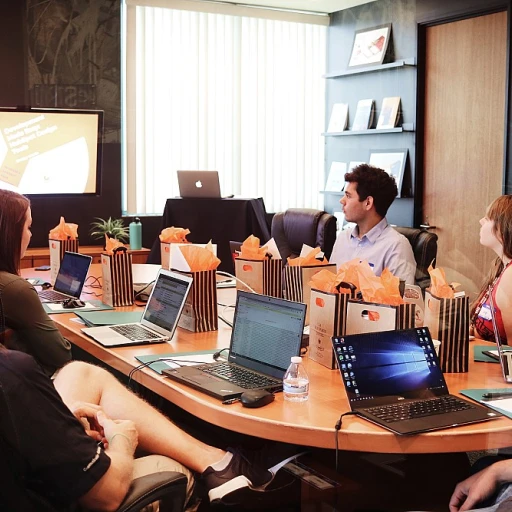Understanding the Importance of Employee Engagement
Unveiling the Core of Engagement in the Workplace
Employee engagement is a crucial determinant of a company's success, influencing productivity, retention, and overall job satisfaction. While there are various engagement initiatives out there, understanding its importance offers a foundation for more effective strategies.
Engaged employees are more than just satisfied—they are deeply connected to their work and committed to making a meaningful contribution. This connection often results in a positive work environment where team members feel valued and recognized. Recognition, after all, plays a pivotal role in fostering engagement by affirming employees' contributions and encouraging continued excellence.
Furthermore, communication within the company can make or break engagement levels. Employees need consistent, transparent, and honest communication from management to feel part of the bigger picture. This not only ensures employees are informed but also helps them feel heard, thus contributing to their mental health and job satisfaction.
As organizations endeavor to boost engagement, understanding the dynamics of work-life balance and career development is paramount. These factors can significantly influence how employees perceive their roles, their long-term career progression, and ultimately, their engagement in their jobs.
In conclusion, employee engagement goes beyond mere participation; it involves cultivating a meaningful connection between employees and their work. By weaving together recognition, communication, and career-focused initiatives, companies can create engagement strategies that resonate with their workforce and drive organizational success.
The Role of Human Resource Management in Engagement
The HR Advantage: Bridging Employee Needs and Company Goals
In today’s dynamic work environment, the connection between human resource management and employee engagement is pivotal. The role of HR extends far beyond traditional functions, acting as the lynchpin in creating a work environment where employees feel valued and understood. Engaged employees are the cornerstone of any successful organization, contributing not only to improved productivity but also to long-term growth.
HR professionals implement engagement programs and initiatives that prioritize communication and recognition. When employees receive recognition not only for their efforts but also for their unique abilities, it enhances their job satisfaction and mental health. Effective HR strategies are sensitive to work-life balance, ensuring team members feel supported both professionally and personally.
Engagement Initiatives as a Driving Force
Crafting meaningful engagement strategies involves gathering insights through engagement surveys and other feedback mechanisms. Understanding employee feedback helps tailor initiatives that align with their career progression aspirations.
- Programs Based on Feedback: Companies that actively listen and adapt their programs according to employee feedback reflect a positive work culture. This engenders a sense of belonging and increases engagement levels.
- Focused Communication: Open lines of communication ensure employees understand their role in the company's strategy. This reduces ambiguity and fosters a committed workforce.
- Recognition and Rewards: Regular recognition of individual and team achievements amplifies a culture of appreciation and respect.
The end goal is to ensure employees not only engage with their daily tasks but feel a deeper connection with the organization’s mission. HR leaders must remain vigilant, continuously seeking innovative strategies to maintain and enhance engagement.
Reskilling: A Key Component of Employee Engagement
Reskilling Initiatives as Catalysts for Employee Engagement
In the constantly evolving job market, companies face the challenge of keeping their workforce engaged and equipped with the necessary skills. Reskilling programs have emerged as a strategic tool to address this challenge. Employees who feel valued and recognized for their contributions tend to be more engaged, and reskilling initiatives play a crucial role in fulfilling this need.
Organizations that implement comprehensive reskilling strategies are promoting a positive work environment that encourages career development and progression. These programs not only enhance the skills of the workforce but also contribute to job satisfaction and engagement levels by providing employees with opportunities for growth and the chance to take on new roles within the company.
Ensuring effective communication and feedback is essential in designing successful reskilling programs. By actively involving team members in the planning and implementation of these initiatives, companies can ensure that the programs align with both organizational goals and the career aspirations of employees. Feedback loops also allow organizations to make necessary adjustments, enhancing the relevance and impact of the training.
Reskilling is not just a solution for filling immediate skill gaps; it plays a long-term role in building a more agile and capable workforce. Employees who undergo reskilling are likely to feel more engaged and satisfied with their work life as they see a path for career development within the company. This further enhances employee engagement strategies and initiatives by motivating employees to contribute meaningfully to organizational success.
For organizations aiming to foster continuous learning and agile work environments, understanding the skills workers use to create successful projects and outcomes is vital. Communication, feedback, and recognition become integral components of effective employee engagement when aligned with reskilling efforts. For more insights on this topic, you can explore the benefits of understanding the skills workers use to create.
Designing Effective Reskilling Programs
Crafting Tailored Skill Development Plans
Creating reskilling programs that genuinely impact employee engagement requires a strategic approach from organizations. At the heart of this initiative lies the need for customized reskilling plans. When companies tailor programs based on individual or team roles, employees feel valued and recognized for their unique contributions to the organization. This personalized approach fosters a positive work environment and enhances job satisfaction.
Incorporating Continuous Feedback Mechanisms
To design effective reskilling programs, it's crucial for companies to incorporate continuous feedback loops. Engaged employees appreciate when their input is considered regarding skill development and career progression. Regular communication and engagement surveys help employers understand their workforce's specific needs and ensure employees are on a path to successful career development. Feedback not only drives program effectiveness but also strengthens communication channels within the company.
Balancing Skill Advancement with Job Satisfaction
Ensuring a balance between reskilling endeavors and employees’ present job responsibilities is essential. Programs should be structured to allow learning during working hours without compromising the employee's work-life balance. Consider scheduling training sessions at times that do not interfere with peak work periods. This approach guarantees that employees stay content both in their current roles and in their long-term career development.
Integrating Engagement Strategies
Reskilling programs should not stand alone but be part of broader engagement initiatives. By incorporating team-building activities and recognition events into these programs, organizations can boost engagement levels among their workforce. When employees require new skills for their professional growth, they often gain a deeper connection to their job and organization, thus becoming more engaged team members. Integrated engagement strategies turn learning into a collaborative experience that promotes mental health and a supportive work culture.
Overcoming Challenges in Reskilling
Addressing and Overcoming Reskilling Hurdles
To successfully implement reskilling initiatives, organizations must navigate a set of common challenges effectively. The first critical step is recognizing these obstacles and tailoring strategies to address them.
One significant challenge is ensuring consistent communication between management and employees. Clear and transparent communication about reskilling objectives helps employees feel involved and valued. Engaging employees in dialogues about their career progression and feedback on existing programs fosters a sense of recognition and increases engagement levels.
Moreover, time allocation is crucial. Employees often struggle to balance reskilling with their current job responsibilities. Companies can implement strategies such as flexible scheduling or integrating reskilling into regular work life to maintain a positive work environment. Ensuring employees find this balance will improve job satisfaction and long-term commitment.
Another hurdle involves employee's mental health and work-life balance. Creating a supportive atmosphere where employees feel confident in expressing their concerns helps mitigate stress associated with skill acquisition. It is important for organizations to provide resources that support mental well-being alongside technical learning.
Overcoming these challenges requires an organizational mindset focused on engagement strategies. Companies should invest in engagement programs that adapt to the feedback of their team members, ensuring initiatives stay relevant and meet evolving employee needs. Engaged employees tend to feel more confident in embracing new roles and pursuing career development.
Furthermore, organizations should foster an environment of continuous learning. By embedding reskilling into the company culture, employees will view it as a natural part of their work life and career advancement. This mindset shift ensures employees recognize the value of reskilling and remain committed to their professional growth.
In conclusion, addressing the challenges of reskilling through effective communication, supportive resources, and adaptable engagement strategies paves the way for successful skill development. These initiatives bolster the work environment, helping employees feel more engaged, recognized, and prepared for future challenges.
Measuring the Impact of Reskilling on Engagement
Evaluating Progress and Outcomes
To truly understand the effectiveness of reskilling as a component of employee engagement, organizations must invest in measuring its impact. One of the ways to achieve this is through regular engagement surveys. These surveys can provide valuable feedback on how reskilling initiatives are perceived by employees and how they enhance overall job satisfaction.
Ensuring employees feel recognized for their efforts in reskilling programs can significantly improve engagement levels. It is recommended to incorporate feedback mechanisms that not only rate the skills acquired but also evaluate how these skills contribute to an employee's role and career progression. Programs that align with an employee's career development goals tend to generate more engaged employees.
In terms of communication, it’s important for organizations to establish clear and consistent channels. This helps employees understand the long term benefits of reskilling initiatives, such as improved job satisfaction and work life balance. Moreover, well-implemented programs promote a positive work environment where employees feel valued and motivated.
To effectively measure the impact, companies can utilize both quantitative and qualitative data. By analyzing metrics like employee retention rates, productivity, and work quality, alongside qualitative insights from open-ended survey responses or team member interviews, organizations gain a comprehensive picture of how reskilling affects engagement.
It's crucial to remember that reskilling is a continuous journey. Companies should remain agile and adapt their engagement strategies as needed based on the feedback received. This not only enriches the employee experience but also ensures that engagement initiatives remain impactful and relevant over time.














